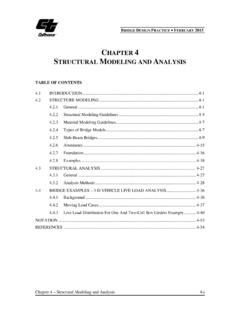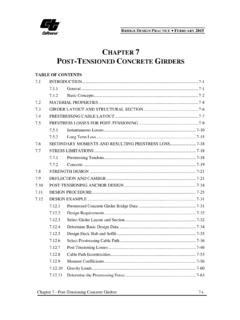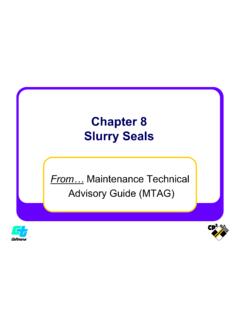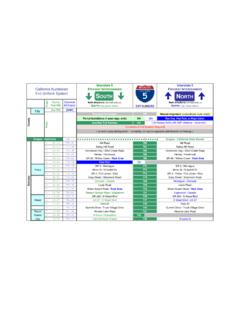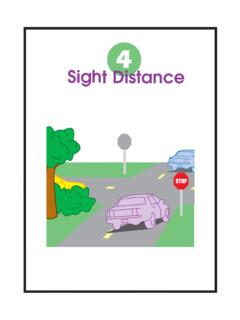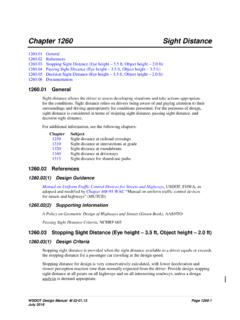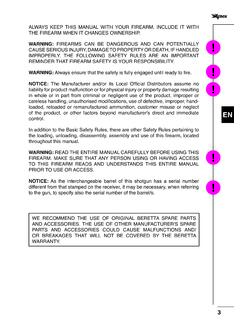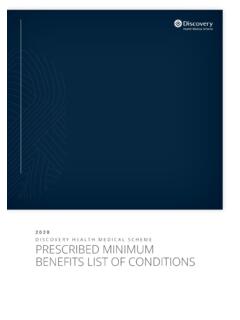Transcription of CHAPTER 200 GEOMETRIC DESIGN AND STRUCTURE …
1 Highway DESIGN Manual 200-1 July 1, 2020 CHAPTER 200 GEOMETRIC DESIGN AND STRUCTURE STANDARDS Topic 201 sight distance Index General sight distance is the continuous length of highway ahead, visible to the highway user. Four types of sight distance are considered herein: passing, stopping, decision, and corner. Passing sight distance is used where use of an opposing lane can provide passing opportunities (see Index ). Stopping sight distance is the minimum sight distance for a given DESIGN speed to be provided on multilane highways and on 2-lane roads when passing sight distance is not economically obtainable. Stopping sight distance also is to be provided for all users, including motorists and bicyclists, at all elements of interchanges and intersections at grade, including private road connections (see Topic 504, Index , & Figure ).
2 Decision sight distance is used at major decision points (see Indexes and ). Corner sight distance is used at intersections (see Index , Figure , and Figure ). Table shows the minimum standards for stopping sight distance related to DESIGN speed for motorists. Stopping sight distances given in the table are suitable for Class II and Class III bikeways. The stopping sight distances are also applicable to roundabout DESIGN on the approach roadway, within the circulatory roadway, and on the exits prior to the pedestrian crossings. Also shown in Table are the values for use in providing passing sight distance . See CHAPTER 1000 for Class I bikeway sight distance guidance. CHAPTER 3 of "A Policy on GEOMETRIC DESIGN of Highways and Streets," AASHTO, contains a thorough discussion of the derivation of stopping sight distance .
3 Passing sight distance Passing sight distance is the minimum sight distance required for the driver of one vehicle to pass another vehicle safely and comfortably. Passing must be accomplished assuming an oncoming vehicle comes into view and maintains the DESIGN speed, without reduction, after the overtaking maneuver is started. 200-2 Highway DESIGN Manual July 1, 2020 Table sight distance Standards DESIGN Speed(1) (mph) Stopping(2) (ft) Passing (ft) 10 50 --- 15 100 --- 20 125 800 25 150 950 30 200 1,100 35 250 1,300 40 300 1,500 45 360 1,650 50 430 1,800 55 500 1,950 60 580 2,100 65 660 2,300 70 750 2,500 75 840 2,600 80 930 2,700 Notes: (1)See Topic 101 for selection of DESIGN speed. (2)For sustained downgrades, refer to underlined standard in Index The sight distance available for passing at any place is the longest distance at which a driver whose eyes are 3 feet above the pavement surface can see the top of an object 4 feet high on the road.
4 See Table for the calculated values that are associated with various DESIGN speeds. In general, 2-lane highways should be designed to provide for passing where possible, especially those routes with high volumes of trucks or recreational vehicles. Passing should be done on tangent horizontal alignments with constant grades or a slight sag vertical curve. Not only are drivers reluctant to pass on a long crest vertical curve, but it is impracticable to DESIGN crest vertical curves to provide for passing sight distance because of high cost where crest cuts are involved. Passing sight distance for crest vertical curves is 7 to 17 times longer than the stopping sight distance . Ordinarily, passing sight distance is provided at locations where combinations of alignment and profile do not require the use of crest vertical curves.
5 Highway DESIGN Manual 200-3 July 1, 2020 Passing sight distance is considered only on 2-lane roads. At critical locations, a stretch of 3- or 4-lane passing section with stopping sight distance is sometimes more economical than two lanes with passing sight distance . Passing on sag vertical curves can be accomplished both day and night because headlights can be seen through the entire curve. See Part 3 of the California Manual on Uniform Traffic Control Devices (California MUTCD) for criteria relating to the placement of barrier striping for no-passing zones. Note, that the passing sight distances shown in the California MUTCD are based on traffic operational criteria. Traffic operational criteria are different from the DESIGN characteristics used to develop the values provided in Table and CHAPTER 3 of AASHTO, A Policy on GEOMETRIC DESIGN of Highways and Streets.
6 The aforementioned table and AASHTO reference are also used to DESIGN the vertical profile and horizontal alignment of the highway. Consult the District Traffic Engineer or designee when using the California MUTCD criteria for traffic operating-control needs. Other means for providing passing opportunities, such as climbing lanes or turnouts, are discussed in Index CHAPTER 3 of AASHTO, A Policy on GEOMETRIC DESIGN of Highways and Streets, contains a thorough discussion of the derivation of passing sight distance . Stopping sight distance The minimum stopping sight distance is the distance required by the user, traveling at a given speed, to bring the vehicle or bicycle to a stop after an object -foot high on the road becomes visible.
7 Stopping sight distance for motorists is measured from the driver's eyes, which are assumed to be 3 feet above the pavement surface, to an object -foot high on the road. See Index (10) for Class I bikeway stopping sight distance guidance. The stopping sight distances in Table should be increased by 20 percent on sustained downgrades steeper than 3 percent and longer than one mile. Stopping sight distance at Grade Crests Figure shows graphically the relationships between length of highway crest vertical curve, DESIGN speed, and algebraic difference in grades. Any one factor can be determined when the other two are known. Stopping sight distance at Grade Sags From the curves in Figure , the minimum length of vertical curve which provides headlight sight distance in grade sags for a given DESIGN speed can be obtained.
8 If headlight sight distance is not obtainable at grade sags, lighting may be considered. The District approval authority or Project Delivery Coordinator, depending upon the current District DESIGN Delegation Agreement, and the District Traffic Engineer or designee shall be contacted to review proposed grade sag lighting to determine if such use is appropriate. 200-4 Highway DESIGN Manual July 1, 2020 Stopping sight distance on Horizontal Curves Where an object off the pavement such as a bridge pier, building, cut slope, or natural growth restricts sight distance , the minimum radius of curvature is determined by the stopping sight distance . Available stopping sight distance on horizontal curves is obtained from Figure It is assumed that the driver's eye is 3 feet above the center of the inside lane (inside with respect to curve) and the object is -foot high.
9 The line of sight is assumed to intercept the view obstruction at the midpoint of the sight line and 2 feet above the center of the inside lane when the road profile is flat ( no vertical curve). Crest vertical curves can cause additional reductions in sight distance . The clear distance (m) is measured from the center of the inside lane to the obstruction . The DESIGN objective is to determine the required clear distance from centerline of inside lane to a retaining wall, bridge pier, abutment, cut slope, or other obstruction for a given DESIGN speed. Using radius of curvature and minimum sight distance for that DESIGN speed, Figure gives the clear distance (m) from centerline of inside lane to the obstruction .
10 See Index (13) for bikeway stopping sight distance on horizontal curve guidance. When the radius of curvature and the clear distance to a fixed obstruction are known, Figure also gives the sight distance for these conditions. See Index for technical reductions in DESIGN speed caused by partial or momentary horizontal sight distance restrictions. See Index for additional comments on glare screens. Cuts may be widened where vegetation restricting horizontal sight distance is expected to grow on finished slopes. Widening is an economic trade-off that must be evaluated along with other options. See Topic 902 for sight distance requirements on landscape projects. Decision sight distance At certain locations, sight distance greater than stopping sight distance is desirable to allow drivers time for decisions without making last minute erratic maneuvers (see CHAPTER III of AASHTO, A Policy on GEOMETRIC DESIGN of Highways and Streets, for a thorough discussion of the derivation of decision sight distance .)
